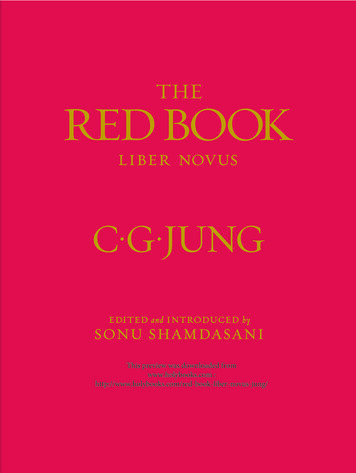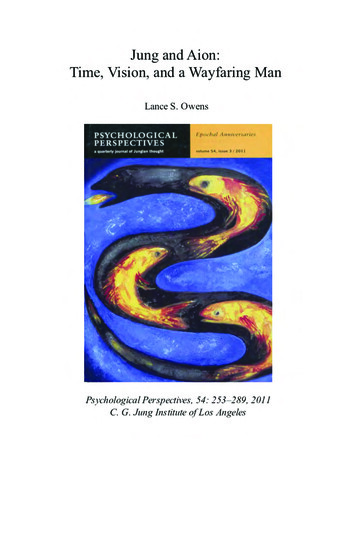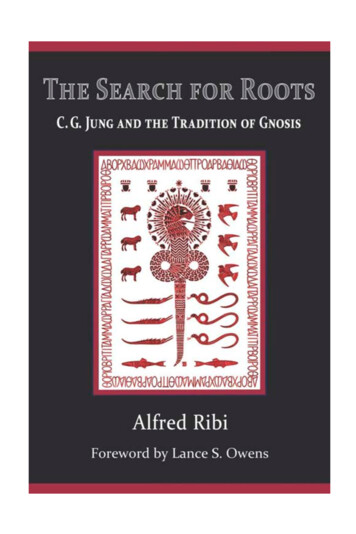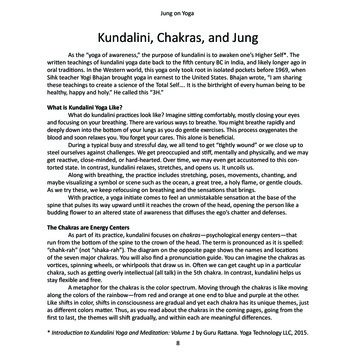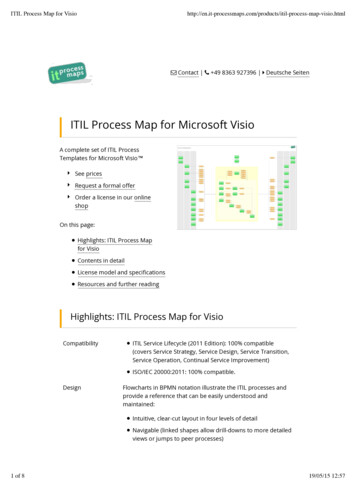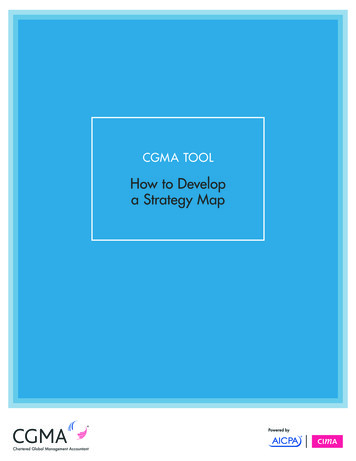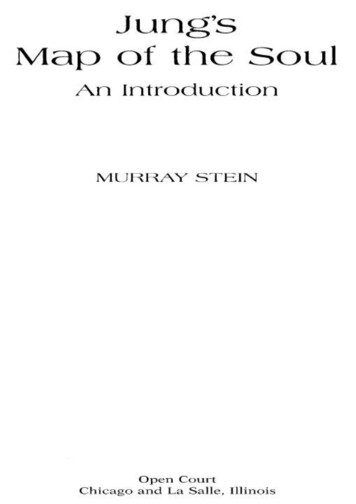
Transcription
Table of ContentsTitle PageDedicationAcknowledgementsIntroductionChapter 1 - Surface:The Relation of Ego to ConsciousnessThe Location of the EgoPsychological TypesPersonal FreedomChapter 2 - The Populated InteriorReaching the UnconsciousThe ComplexesLevels of the UnconsciousPsychic ImagesPersonality FragmentsThe Structure of ComplexesThe Eruption of ComplexesChapter 3 - Psychic EnergySexuality and LibidoThe Transformation of Psychic EnergyPhysics as a Model
The Source of EnergyMeasurement of Psychic EnergyThe Unity of Body and MindEnergy, Movement, and DirectionTransformations and SymbolsChapter 4 - The Psyche’s BoundariesArchetypes (Psychic Universals)The UnconsciousInstinctsThe Relationship between Archetypes and InstinctsChapter 5 - The Revealed and the Concealed in Relations with OthersThe Ego’s ShadowThe Making of the ShadowThe PersonaThe Two Sources of the PersonaPersona DevelopmentThe Persona’s TransformationsIntegrating Persona and ShadowChapter 6 - The Way to the Deep InteriorDefining Anima and AnimusGender and Anima and AnimusThe Development of the Anima/usRaising Consciousness with Anima/usSexuality and Relationships
Chapter 7 - The Psyche’s Transcendent Center and WholenessJung’s Experience of the SelfJung’s Definition of the SelfSymbols of the SelfThe Self as Central Mystery of the PsycheChapter 8 - Emergence of the SelfThe Psychological LifespanIndividuationThe Five Stages of ConsciousnessA Case Study in IndividuationThe Movements of the SelfChapter 9 - Of Time and EternityPatterns in ChaosDeveloping the Idea of SynchronicitySynchronicity and CausalitySynchronicity and Archetypal TheoryMind and MatterAbsolute KnowledgeA New ParadigmCosmologyNotesGlossary
ReferencesIndexCopyright Page
For Sarah and Christopher
AcknowledgmentsThis book would not have been possible without the patient typing andeditorial assistance of Lynne Walter. I want to thank her for her dedication andunflagging optimism. I would also like to thank Jan Marlan for herencouragement and enthusiastic support. Those who have sat through mylectures over the years will recognize their contributions in the many points ofdetail that would not be in this text but for their questions and observations.Thanks to all of you.
IntroductionYou could timidly explore thecoasts of Africa to the south,but going west there was nothingexcept fear, the unknown, not“our sea” but the Sea of Mystery,Mare Ignotum.Carlos FuentesThe Buried MirrorThe summer Jung died, I was preparing to go to college. It was 1961. Humanswere beginning to explore outer space, and the race was on to see who wouldbe the first to reach the moon, the Americans or the Russians. All eyes werefocused on the great adventure of space exploration. For the first time inhuman history, people were succeeding in leaving terra firma and travelingtoward the stars. What I did not realize at the time was that our century hasbeen marked just as decisively by the journeys inward, the great explorationsof the inner world undertaken by the likes of Carl Jung in the decades beforeSputnik and Apollo. What John Glenn and Neil Armstrong have meant to usas explorers of outer space, Jung signifies with regard to inner space, acourageous and intrepid voyager into the unknown.Jung died peacefully in his house just outside Zurich, in a room that facedthe calm lake to the west. To the south one could see the Alps. The day beforehe passed away he asked his son to help him to the window to take a last lookat his beloved mountains. He had spent a lifetime exploring inner space anddescribing what he found there in his writings. By coincidence it happenedthat the year Neil Armstrong stepped onto the surface of the moon I embarkedon a journey to Zurich, Switzerland to study at the Jung Institute. What I amsharing in this volume is the distillation of nearly thirty years of studyingJung’s map of the soul.The aim of this book is to describe Jung’s findings as he presented them inhis published writings. First discovering Jung can itself be something likeplunging into that “Sea of Mystery” written about by Fuentes in his accountof earlier explorers who ventured across the Atlantic from Spain. It is with a
sense of excitement, but also fear, that one launches out into these farreaching places. I remember my first attempts. I was swept away by so muchexcitement at the prospect that I anxiously sought the advice of several of myuniversity professors. I wondered if this was “safe.” Jung was so attractivethat he seemed too good to be true! Would I become lost, confused, misled?Luckily for me, these mentors gave me the green light, and I have beenjourneying and finding treasures ever since.Jung’s own original journey was even more frightening. He literally had noidea if he was going to find a treasure or fall over the edge of the world intoouter space. The unconscious was truly a Mare Ignotum when he first lethimself into it. But he was young and courageous, and he was determined tomake some new discoveries. So away he went.Jung often referred to himself as a pioneer and explorer of the unchartedmystery that is the human soul. He seems to have had an adventuresomespirit. For him—as for us still—the human psyche was a vast territory, and inhis day it had not yet been much studied. It was a mystery that challenged theadventuresome with the prospect of rich discovery and frightened the timidwith the threat of insanity. For Jung the study of the soul also became a matterof grave historical importance, for, as he once said, the whole world hangs ona thread and that thread is the human psyche. It is vital that we all becomemore familiar with it.The great question is, of course: Can the human soul ever be known, itsdepths plumbed, its vast territory charted? It was perhaps some leftovernineteenth-century scientific grandiosity that led early pioneers of depthpsychology like Jung and Freud and Adler ever to undertake this effort and tothink that they could define the ineffable and the supremely inscrutablehuman psyche. But set out into this Mare Ignotum they did, and Jung becamea Christopher Columbus of the inner world. The twentieth century has beenan age of scientific breakthroughs and technological wonders of all kinds; ithas also been an age of deep introspection and probing into our commonhuman subjectivity, which have resulted in the field broadly known today asdepth psychology.One way to familiarize ourselves with the psyche is to study the maps of itthat have been drawn up and made available by these great pioneers. In theirworks we can find many points of orientation for ourselves, and perhaps wetoo will be stimulated to carry out further investigations and to make newdiscoveries. Jung’s map of the psyche, as preliminary and perhaps unrefinedand open-ended as it is—as are all first attempts at charting unknown
territories—can still be a great boon to those who want to enter inner space,the world of the psyche, and not lose their way completely.In this book, I accept Jung in his self-designated role of explorer andmapmaker, and I let this image guide me in presenting this introduction to histheory of the human psyche. The psyche is the territory, the unknown realmhe was exploring; his theory is the map he created to communicate hisunderstanding of the psyche. So it is Jung’s map of the soul that I will attemptto describe in this book by leading you, the reader, into and through theterritory of his writings. In doing so, I am presenting a map of a map, but onethat I hope will be useful to you in your own further journeys into Jung’s lifeand work.Like all mapmakers, Jung worked with the instruments and evidenceavailable to him in his time. Born in 1875, he completed his basic medicalstudies at the University of Basel in Switzerland by 1900 and his psychiatrictraining at the Burghölzli Klinik in Zurich by 1905. His important associationwith Freud extended from 1907 to 1913, after which he spent some years in adeep self-analysis and then emerged with his own distinctive psychologicaltheory—called analytical psychology—which he presented to the world in1921 in the book Psychological Types.1 By 1930, aged 55, he had createdmost of the basic features of his theory but had not yet detailed a number ofimportant items. The details would be presented in the years following 1930and would continue to flow from Jung’s pen until he died in 1961.The project of exploring the human psyche scientifically was begun earlyin Jung’s adult life. His first official expedition is described in his doctoralstudy, On the Psychology and Pathology of So-Called Occult Phenomena.2This gives a psychological account of the inner world of a gifted youngwoman whom we now know was actually his own cousin, Helene Preiswerk.As a teenager, she had the unusual ability to act as a medium for spirits of thedead, who would speak through her in remarkably accurate historical voicesand accents. Jung was fascinated and set out to understand and interpret thispuzzling psychological phenomenon. Pressing ahead, he used the wordassociation test to uncover hidden features of the psychic landscape that hadnot been classified before. These were published in numerous papers, whichare now housed in Volume 2 of his Collected Works. The newly discoveredfeatures of the unconscious he named “complexes,” a term that would stickand make him famous. After that, he took up two burning psychiatricproblems of the day, psychosis and schizophrenia, and produced a book, ThePsychology of Dementia Praecox, 3 which he sent to Freud as an example of
his work and as a suggestion for how some of Freud’s ideas could be appliedin psychiatry (Freud was a neurologist). After receiving Freud’s warm andenthusiastic response, he entered into a professional relationship with him andquickly became the leader of the fledgling psychoanalytic movement. Withthis he began his study of the shadowy regions of neurotic conditions, landingfinally on the discovery of more or less invariant universal fantasies andpatterns of behavior (the archetypes) in an area of the deep psyche that hecalled the “collective unconscious.” The description and detailed account ofthe archetype and the collective unconscious would become his signature, amark that sets his map apart from those of all other explorers of the deeppsyche, the unconscious.The year 1930 divides Jung’s professional life almost exactly in half: in1900 he began his training and psychiatric studies at the Burghölzli Klinik,and in 1961 he died a wise old man in his home at Küsnacht on Lake Zürich.In retrospect, one can see that Jung’s first thirty years of professional activitywere profoundly creative. During these years, he generated the basic elementsof a monumental psychological theory as well as addressed major collectiveissues of the day. The second thirty years were perhaps less innovative of newtheoretical constructs, but the output of books and articles was even greaterthan it had been earlier. These were the years of deepening and validatingearlier hypotheses and intuitions. He extended his theories further to includestudies of history, culture, and religion and to create a key link to modernphysics. Jung’s clinical work with psychiatric patients and with analysandswas more consuming and intense in the first half of his professional life; ittapered off to a minimum after 1940, when the war interrupted normalcollective life in Europe and Jung himself shortly thereafter also suffered aheart attack.Jung’s investigation of the psyche was also highly personal. His explorationof the unconscious mind was not only carried out on patients andexperimental subjects. He also analyzed himself. In fact, for a time he becamehis own prime subject of study. By carefully observing his own dreams anddeveloping the technique of active imagination, he found a way to enter evermore deeply into the hidden spaces of his inner world. To understand hispatients and himself, he developed a method of interpretation that drew uponcomparative studies in human culture, myth, and religion; in fact, he used anyand all materials from world history that had a bearing on mental processes.This method he called “amplification.”The many sources and origins of Jung’s thought have not yet been clearlyworked out in detail. In his writings, he acknowledges a debt to many earlier
thinkers, among them Goethe, Kant, Schopenhauer, Carus, Hartmann, andNietzsche; most importantly, he places himself in the lineage of the ancientGnostics and the medieval alchemists. His philosopher of choice was Kant.The influence of Hegel’s dialectic is also apparent in his theorizing. AndFreud left a mark. While Jung’s thought can be shown to have developed andgrown over the years that span his career, however, there is a remarkablecontinuity in his basic intellectual orientation. Some of Jung’s readers havefound seeds of his later psychological theories already apparent in somecollege papers delivered at his fraternity and published as The ZofingiaLectures. These were composed before 1900 while he was still anundergraduate at the University of Basel. The historian Henri Ellenbergergoes so far as to claim that the “germinal cell of Jung’s analytical psychologyis to be found in his discussion of the Zofingia Students Association and inhis experiments with his young medium cousin, Helene Preiswerk.”4 TheZofingia lectures show Jung’s early struggles with issues that would occupyhim throughout his life, such as the question of exposing religion and mysticalexperience to scientific, empirical investigation. Even as a young man, Jungargued that such subjects should be opened up to empirical research andapproached with an open mind. When he met William James in 1909 at ClarkUniversity, it was a high point, because James had adopted the same positionand had produced his classic study, Varieties of Religious Experience, usingprecisely this type of method.From all of this study and experience, then, Jung drew up a map of thehuman soul. It is a map that describes the psyche in all of its dimensions, andit also tries to explain its internal dynamics. But Jung was always careful torespect the psyche’s ultimate mystery. His theory can be read as a map of thesoul, but it is the map of a mystery that cannot be ultimately captured inrational terms and categories. It is a map of a living, Mercurial thing, thepsyche.In reading Jung, also, one needs to keep in mind that the map is not theterritory. Knowledge of the map is not the same as an experience of the deeppsyche. At best, the map can be a useful tool for those who want orientationand guidance. For some who are lost, it can even be a lifesaver. For others, itwill stimulate a powerful urge to experience what Jung is talking about. Ibegan to write down my dreams when I first read Jung. Later I evenjourneyed to Zürich and studied for four years at the Jung Institute. Throughanalysis and personal experience of the unconscious, I have gained firsthandknowledge of many of Jung’s findings. And yet my inner world is notidentical to his. His map can show the way and can indicate general outlines,
but it does not offer specific content. This must be discovered for oneself.For many features of the map, Jung relied on scientific intuition and anamazingly vigorous imagination. The methods of science in his day could notconfirm or disprove his hypothesis about the collective unconscious, forinstance. Today we are closer to being able to do that. But Jung was an artistwho used his creative thoughts to fashion a picture of the inner world of themind. Like those beautifully illustrated maps of Antiquity and theRenaissance—drawn before mapmaking became scientific—the map thatJung created is gorgeous, not only abstract. Here one can find mermaids anddragons, heroes and evil characters. As a scientific investigator, of course, hewas obliged to test his hunches and hypothetical constructs empirically. Butthis still left plenty of room for mythic imagination.Jung worked in the discipline of psychiatry, or medical psychology as hesometimes refers to it. His chief teacher in the early years of hisapprenticeship at the Burghölzli Klinik in Zurich was the well-known Swisspsychiatrist Eugen Bleuler, who coined the term “schizophrenia” to refer toone of the most severe of mental illnesses and wrote a great deal about thepsychological issue of ambivalence. As much as possible, Jung searched forevidence and verification for his theories and hypotheses from sources outsideof himself and his own immediate experience. His range of reading and studywas vast. His claim was that as an empirical investigator of the psyche he wasdrawing a map that described not only the territory of his own inner world butone that referred to the features of the human soul in general. Like other greatartists, the pictures he painted would have the power to speak to people ofmany generations and cultures.My view is that this Swiss psychologist, whose name is today so widelyknown and highly regarded but whose own work is often not carefully readand frequently criticized for being inconsistent and contradictory, actuallyproduced a coherent psychological theory. I think of it as a three-dimensionalmap that shows the levels of the psyche as well as the dynamic interrelationsamong them. It is a self-consistent work of art that appeals to some and not toothers. Its postulates are cast as scientific propositions, and yet many of theseare extremely hard to prove or disprove empirically. Important work is goingon in this area, but whatever the outcomes may show, Jung’s body of workwill continue to attract attention and admiration. Works of art never becomeoutdated, although maps may lose their relevance with the progress of timeand changes in methodology.To describe Jung’s map of the psyche in a brief book is not a completely
novel project, and others, notably Jolande Jacobi and Frieda Fordham, haveproduced similar introductory works in days of yore. What my work adds, Ihope, is an emphasis on the overarching coherence within the theory and itssubtle network of interconnections. As the theory is often presented, there is abit of this and a bit of that, and the point that all the pieces stem from a singleunified vision—which I see as a sublime vision of the soul—is not soobvious. It is also the case that a considerable number of years have passedsince these earlier introductions to Jung’s theory were offered, and the time isripe for a new one.My aim is to show that while gaps and inconsistencies do exist in Jung’smap, there is a more profound underlying unity of vision that far outweighsthe occasional lapses from logical precision. My main interest in this accountis not to show the development of Jung’s thought or to consider at any lengthits practical applications in psychotherapy and analysis. It is rather to exposethe underlying intellectual unity beneath the welter of commentary and detailthat constitute his complete oeuvre. The careful reader will, I hope, comeaway from this book with a general picture of the theory of analyticalpsychology as Jung himself expounded it, as well as a grasp on the mostimportant details and how they belong to a single whole.The reason for the remarkable unity in Jung’s account of the psyche stems,I believe, from a feature of his thought that did not grow out of his empiricalmethodology. Jung was an intuitive creative thinker, after the fashion ofoldtime philosophers like Plato and Schopenhauer. He created his map of thepsyche from the ideas available in the general scientific and intellectualcommunity of his day, but he gave these ideas a unique twist. He did notcome up so much with radical new notions as take what was generallyavailable and fashion a new and highly distinctive pattern out of it. Like agreat artist working in a tradition of painting, he used the images andmaterials that were available to him and made something new which had notbeen seen before in quite the same combination of elements.Jung was also a visionary in the tradition of Meister Eckhart, Boehme,Blake, and Emerson. Many of his most important intuitions originated in hisexperiences of the sublime, which came to him in dreams, visions, and activeimagination. He confesses this openly in his autobiography, where he writesthat his prime teacher about the “reality of the psyche” was the figurePhilemon, who first appeared to him in a dream and whom he then engagedfor years in active imagination.5 Direct experience of the soul is the ultimatesource of Jung’s theory, and this accounts for its deep internal unity and selfconsistency.
But Jung was also a dedicated scientist, and this sets his work apart fromthe writings of poets and mystics. He worked with the scientific method,which meant that he held his work accountable to the scientific communityand subjected it to empirical tests. His visions, intuitions, and innerrealizations were not simply allowed to rest on their own merit; they werechecked against the evidence of human experience in general. Jung’s strongneed to be scientific and empirical accounts for the unbeveled edges in histheory, for the rough approximations that could have been made muchsmoother by pure intellect and imagination. The empirical world—life as it isexperienced—is messy and does not fit neatly into the boxes made by humanthought and imagination. Because Jung was both a visionary intuitive thinkerand an empirical scientist, his map of the human psyche is both coherent andyet only loosely systematic and self-consistent.One reason I have continued to appreciate Jung’s writings and have readhim steadily for over twenty-five years is that he is not compulsivelyconsistent. When I have studied truly systematic thinkers such as Tillich orHegel, I have always squirmed in the tight jaws of their steely minds. Theirthoughts are too highly organized for me. Where is the messiness, thejuiciness of life? This has led me to look to artists and poets for wisdom ratherthan primarily to philosophers and theologians. I am suspicious of rigidsystems. They feel paranoid to me. Jung’s writings have never affected me inthis way.Reading Jung, I have always sensed his deep respect for the mysteries ofthe human psyche, and this attitude allows the horizons to go on expanding.His map opens vistas up rather than closes them off. I hope I will be able tocommunicate this same impression to you, the reader.This is an introductory work. Although I do hope that even advanced studentsof Jung’s psychology will benefit from reading it, my true audience is thosewho would like to know what Jung said but have not yet found the right entryinto his massive writings and complex thinking. Each chapter of this book isfocused on one theme in his theory. I look at specific passages from hisCollected Works that lay out that piece of his map. The especially motivatedand diligent reader can consult those references later at leisure. My textcentered presentation will, I hope, offer a friendly invitation to becomeimmersed in the primary documents and to face the challenge of teasing outJung’s sometimes obscure meaning and reflecting upon its implications.
The selection of these readings is my own personal choice. Other equallyvaluable texts could have been cited and used just as well. I have tried tochoose the clearest and most representative essays and passages from Jung’swork to demonstrate the essential coherence of his vision. Jung’s map of thepsyche is a massive achievement of intellect, observation, and creativeintuition. Few modern thinkers have come close to equaling this toweringwork, which is housed in the eighteen volumes of the Collected Works, thethree volumes of Letters, the various collections of interviews and occasionalwritings, and his autobiography (written with Aniela Jaffe). From thismountain of material I have selected the topics that belong most essentially tohis theory and have left out those that have to do with analytical practice andinterpretation of culture, history, and religion.I come back to the question I asked before: Is there really a system inJung’s works? Is he a systematic thinker? The answer is probably a guardedyes. The theory is coherent, in the same way that Switzerland is a coherentcountry although the population speaks four different languages. The wholehangs together even though the parts look as if they could stand alone andfunction quite independently. Jung did not think systematically in the way aphilosopher does, building on basic premises and making certain that the partsfit together without contradiction. He claimed to be an empirical scientist, andso his theorizing matches the disorderliness of the empirical world. Anintuitive thinker, Jung lays out big concepts, elaborates them in some detail,and then proceeds to other big concepts. He backtracks frequently, repeatshimself, and fills in gaps as he goes along. This quality makes for difficulty inreading him. One has to know all of his work in order to get the picture. Ifyou read more or less randomly in his works for a while, you begin to suspectthat the pieces fit together somehow in Jung’s own mind, but only afterreading his whole work and considering it for a long time can you see howthey really do.I think Jung felt that, having become aware of the profundity and farreaches of the human psyche through his clinical work and his ownexperience, he had to work patiently over a considerable length of time inorder to formulate responsibly this sublime vision of the human soul. Hewould not rush it, and often he delayed publishing for years while he workedat building the structures that could support his thought in the intellectualcommunity. As we try to grasp this vision in its full magnitude, we need tobear in mind that he elaborated it over a period of some sixty years. Weshould not be overly obsessed with exact consistency in a work this large andin one that is attuned to empirical reality.
A story is told of Jung by his students in Zurich. Once when he wascriticized for being inconsistent on some point of theory, he responded: I havemy eye on the central fire, and I am trying to put some mirrors around it toshow it to others. Sometimes the edges of those mirrors leave gaps and don’tfit together exactly. I can’t help that. Look at what I’m trying to point to!I take it as my task to describe as accurately as possible what Jung shows inthese mirrors. It is a vision that has sustained many people in our generationand may be a vision for the foreseeable future. Above all, his writings provideus with images of a great mystery, the human psyche.
1Surface:(Ego-Conconscious)I will begin unrolling Jung’s map of the psyche by looking at his descriptionof human consciousness and its most central feature, the ego. “Ego” is atechnical term whose origin is the Latin word meaning “I.” Consciousness isthe state of awakeness, and at its center there is an “I.” This is an obviousstarting point, and it is the entrance to the vast inner space that we call thepsyche. It is also a complex feature of the psyche, one that still holds manypuzzles and unanswered questions.Although Jung was more interested in discovering what lay beneathconsciousness in the hinterlands of the psyche, he also took on the task ofdescribing and explaining human consciousness. He wanted to create acomplete map of the psyche, so this was unavoidable: ego-consciousness is aprime feature of the territory he was exploring. Jung cannot really be calledan ego psychologist, but he did place a social value on the ego. He offered anaccount of the ego’s functions, and he recognized the critical importance ofgreater consciousness for the future of human life and for culture. Moreover,he was acutely aware that ego-consciousness is itself the prerequisite forpsychological investigation. It is the tool. Our knowledge as human beingsabout anything at all is conditioned by the capacities and limitations of ourconsciousness. To study consciousness, therefore, is to direct attention to theinstrument that one is using for psychological investigation and exploration.Why is it so important, especially in psychology, to understand the natureof ego-consciousness? It is because one needs to make adjustments fordistortion. Jung said that every psychology is a personal confession.1 Everycreative psychologist is limited by his or her own personal biases andunexamined assumptions. Not all that seems true to even the most earnest and
sincere investigator’s consciousness is necessarily accurate knowledge. Muchthat passes for knowledge among human beings is actually, upon closer andmore critical inspection, merely prejudice or belief based on distortion, bias,hearsay, speculation, or pure fantasy. Beliefs pass as knowledge and are clungto as reliable certainties. “I believe in order that I may understand,” a famousremark from St. Augustine, may sound strange to our modern ears today, andyet this is often the case when people begin to speak about psychologicalreality. Jung seriously sought to examine the foundations of his own thinkingby critically examining the instrument he was using to make his discoveries.He argued strongly that a critical understanding of consciousness is essentialfor science, just as it has been for philosophy. Accurate understanding of thepsyche, or of anything else for that matter, depends upon the state of one’sconsciousness. Jung wanted to offer a critical understanding of consciousness.This was his primary objective in writing the key work, Psychological Types,which describes eight cognitive styles that distinguish human consciousnessand process information and life experience differently.The Relation of Ego to ConsciousnessJung therefore writes a great deal about ego-consciousness throughout hispublished works. For my purposes here, I will discuss primarily the firstchapter of the late work Aion, entitled “The Ego,” as well as some relatedte
understanding of the psyche. So it is Jung’s map of the soul that I will attempt to describe in this book by leading you, the reader, into and through the territory of his writings. In doing so, I am presenting a map of a map, but one that I hope will be useful to you in your own fur

